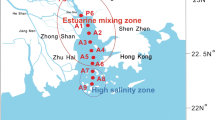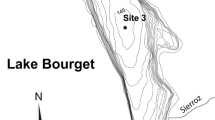Abstract
Lakes are widely distributed on the Tibetan Plateau, which plays an important role in natural methane emission. Aerobic methanotrophs in lake sediments reduce the amount of methane released into the atmosphere. However, no study to date has analyzed the methanotroph community composition and their driving factors in sediments of these high-altitude lakes (>4000 m). To provide new insights on this aspect, the abundance and composition in the sediments of six high-altitude alkaline lakes (including both freshwater and saline lakes) on the Tibetan Plateau were studied. The quantitative PCR, terminal restriction fragment length polymorphism, and 454-pyrosequencing methods were used to target the pmoA genes. The pmoA gene copies ranged 104–106 per gram fresh sediment. Type I methanotrophs predominated in Tibetan lake sediments, with Methylobacter and uncultivated type Ib methanotrophs being dominant in freshwater lakes and Methylomicrobium in saline lakes. Combining the pmoA-pyrosequencing data from Tibetan lakes with other published pmoA-sequencing data from lake sediments of other regions, a significant salinity and alkalinity effect (P = 0.001) was detected, especially salinity, which explained ∼25% of methanotroph community variability. The main effect was Methylomicrobium being dominant (up to 100%) in saline lakes only. In freshwater lakes, however, methanotroph composition was relatively diverse, including Methylobacter, Methylocystis, and uncultured type Ib clusters. This study provides the first methanotroph data for high-altitude lake sediments (>4000 m) and shows that salinity is a driving factor for the community composition of aerobic methanotrophs.




Similar content being viewed by others
References
IPCC (2014) In: Core Writing Team, Pachauri RK, Meyer LA (eds) Climate Change 2014: Synthesis report. Contribution of working groups I, II and III to the fifth assessment report of the intergovernmental panel on climate change. IPCC, Geneva, p 151
Bastviken D, Cole J, Pace M et al (2004) Methane emissions from lakes: dependence of lake characteristics, two regional assessments, and a global estimate. Glob Biogeochem Cycles 18:GB4009. doi:10.1029/2004gb002238
Frenzel P, Thebrath B, Conrad R (1990) Oxidation of methane in the oxic surface layer of a deep lake sediment (Lake Constance). FEMS Microbiol Ecol 73:149–158. doi:10.1128/aem.01350-08
Bowman J (2000) The methanotrophs. The families Methylococcaceae and Methylocystaceae. In: Dworkin M (ed) The prokaryotes. Springer, New York, pp 266–289
Semrau JD, DiSpirito AA, Yoon S (2010) Methanotrophs and copper. FEMS Microbiol Rev 34:496–531. doi:10.1111/j.1574-6976.2010.00212.x
Knief C (2015) Diversity and habitat preferences of cultivated and uncultivated aerobic methanotrophic bacteria evaluated based on pmoA as molecular marker. Front Microbiol 6:1346. doi:10.3389/fmicb.2015.01346
Lüke C, Frenzel P (2011) Potential of pmoA amplicon pyrosequencing for methanotroph diversity studies. Appl Environ Microbiol 77:6305–6309. doi:10.1128/aem.05355-11
Dumont MG, Murrell JC (2005) Community-level analysis: key genes of aerobic methane oxidation. Methods Enzymol 397:413–427. doi:10.1016/s0076-6879(05)97025-0
Lin JL, Radajewski S, Eshinimaev BT et al (2004) Molecular diversity of methanotrophs in Transbaikal soda lake sediments and identification of potentially active populations by stable isotope probing. Environ Microbiol 6:1049–1060. doi:10.1111/j.1462-2920.2004.00635.x
Rahalkar M, Deutzmann J, Schink B et al (2009) Abundance and activity of methanotrophic bacteria in littoral and profundal sediments of Lake Constance (Germany). Appl Environ Microbiol 75:119–126. doi:10.1128/aem.01350-08
He R, Wooller MJ, Pohlman JW et al (2015) Methane-derived carbon flow through microbial communities in arctic lake sediments. Environ Microbiol 17:3233–3250. doi:10.1111/1462-2920.12773
Yang YY, Zhao Q, Cui YH et al (2015) Spatio-temporal variation of sediment methanotrophic microorganisms in a large eutrophic lake. Microb Ecol 71:9–17. doi:10.1007/s00248-015-0667-7
Liu Y, Zhang JX, Zhao L et al (2015) Aerobic and nitrite-dependent methane-oxidizing microorganisms in sediments of freshwater lakes on the Yunnan Plateau. Appl Microbiol Biotechnol 99:2371–2381. doi:10.1007/s00253-014-6141-5
Khmelenina VN, Eshinimaev BT, Kalyuzhnaya MG et al (2000) Potential activity of methane and ammonium oxidation by methanotrophic communities from the soda lakes of Southern Transbaikal. Microbiology 69:460–465. doi:10.1007/BF02756771
Lin JL, Joye SB, Scholten JCM et al (2005) Analysis of methane monooxygenase genes in Mono Lake suggests that increased methane oxidation activity may correlate with a change in methanotroph community structure. Appl Environ Microbiol 71:6458–6462. doi:10.1128/aem.71.10.6458-6462.2005
Trotsenko YA, Khmelenina VN (2002) The biology and osmoadaptation of haloalkaliphilie methanotrophs. Microbiology 71:123–132. doi:10.1023/a:1015183832622
Khmelenina VN, Kalyuzhnaya MG, Starostina NG et al (1997) Isolation and characterization of halotolerant alkaliphilic methanotrophic bacteria from Tuva soda lakes. Curr Microbiol 35:257–261. doi:10.1007/s002849900249
Sorokin DY, Kuenen JG (2005) Chemolithotrophic haloalkaliphiles from soda lakes. FEMS Microbiol Ecol 52:287–295. doi:10.1016/j.femsec.2005.02.012
Eshinimaev BT, Khmelenina VN, Trotsenko YA (2008) First isolation of a type II methanotroph from a soda lake. Microbiology 77:628–631. doi:10.1134/s0026261708050196
Carini S, Bano N, LeCleir G et al (2005) Aerobic methane oxidation and methanotroph community composition during seasonal stratification in Mono Lake, California (USA). Environ Microbiol 7:1127–1138. doi:10.1111/j.1462-2920.2005.00786.x
Bian D, Yang Z, Li L et al (2006) The response of lake area change to climate variations in north Tibetan Plateau during last 30 years. Acta Geol Sin 5:510–518
Zheng M (1997) An introduction to saline lakes on the Qinghai-Tibet Plateau. Springer, Netherlands
He R, Wooller MJ, Pohlman JW et al (2012) Identification of functionally active aerobic methanotrophs in sediments from an arctic lake using stable isotope probing. Environ Microbiol 14:1403–1419. doi:10.1111/j.1462-2920.2012.02725.x
Xiong JB, Liu YQ, Lin XG et al (2012) Geographic distance and pH drive bacterial distribution in alkaline lake sediments across Tibetan Plateau. Environ Microbiol 14:2457–2466. doi:10.1111/j.1462-2920.2012.02799.x
Liu YQ, Yao TD, Jiao NZ et al (2013) Salinity impact on bacterial community composition in five high-altitude lakes from the Tibetan Plateau, Western China. Geomicrobiol J 30:462–469. doi:10.1080/01490451.2012.710709
Liu YQ, Priscu JC, Xiong JB et al (2016) Salinity drives archaeal distribution patterns in high altitude lake sediments on the Tibetan Plateau. FEMS Microbiol Ecol. doi:10.1093/femsec/fiw033
Costello AM, Lidstrom ME (1999) Molecular characterization of functional and phylogenetic genes from natural populations of methanotrophs in lake sediments. Appl Environ Microbiol 65:5066–5074
Kolb S, Knief C, Stubner S et al (2003) Quantitative detection of methanotrophs in soil by novel pmoA-targeted real-time PCR assays. Appl Environ Microbiol 69:2423–2429. doi:10.1128/aem.69.5.2423-2429.2003
Deng YC, Cui XY, Lüke C et al (2013) Aerobic methanotroph diversity in Riganqiao peatlands on the Qinghai-Tibetan Plateau. Environ Microbiol Rep 5:566–574. doi:10.1111/1758-2229.12046
Schloss PD, Westcott SL, Ryabin T et al (2009) Introducing mothur: open-source, platform-independent, community-supported software for describing and comparing microbial communities. Appl Environ Microbiol 75:7537–7541. doi:10.1128/aem.01541-09
Dumont MG, Pommerenke B, Casper P et al (2011) DNA-, rRNA- and mRNA-based stable isotope probing of aerobic methanotrophs in lake sediment. Environ Microbiol 13:1153–1167. doi:10.1111/j.1462-2920.2010.02415.x
Kim OS (2007) Diversity of functional genes in the aquatic nitrogen cycle. PhD Thesis, Christian-Albrechts-Universität, Kiel
Antony CP, Kumaresan D, Hunger S et al (2013) Microbiology of Lonar Lake and other soda lakes. ISME J 7:468–476. doi:10.1038/ismej.2012.137
Ludwig W, Strunk O, Westram R et al (2004) ARB: a software environment for sequence data. Nucleic Acids Res 32:1363–1371. doi:10.1093/nar/gkh293
De Mendiburu F, Simon R (2015) Agricolae—ten years of an open source statistical tool for experiments in breeding, agriculture and biology. PeerJ PrePrints 3, e1748. doi:10.7287/peerj.preprints.1404v1
Anderson MJ, Willis TJ (2003) Canonical analysis of principal coordinates: a useful method of constrained ordination for ecology. Ecology 84:511–525. doi:10.1890/0012-9658(2003)084[0511:CAOPCA]2.0.CO;2
Hammer UT (1986) Saline lake ecosystems of the world. Dr W Junk, Dordrecht
Oksanen J, Blanchet FG, Kindt R et al (2016) Vegan: community ecology package
Wang SM, Dou HS (1998) Chinese lake records. Science Press, Beijing
Schlegel I, Scheffler W (1999) Seasonal development and morphological variability of Cyclotella ocellata (Bacillariophyceae) in the eutrophic Lake Dagow (Germany). Int Rev Hydrobiol 84:469–478. doi:10.1002/iroh.199900041
Salka I, Cuperova Z, Masin M et al (2011) Rhodoferax-related pufM gene cluster dominates the aerobic anoxygenic phototrophic communities in German freshwater lakes. Environ Microbiol 13:2865–2875. doi:10.1111/j.1462-2920.2011.02562.x
Furtado ALS, Casper P, Esteves FA (2001) Bacterioplankton abundance, biomass and production in a Brazilian coastal lagoon and in two German lakes. An Acad Bras Cienc 73:39–49. doi:10.1590/s0001-37652001000100005
Krambeck HJ, Albrecht D, Hickel B, Hofmann W, Arzbach HH (1993) Limnology of the Plußsee. In: Overbeck J, Chrost RJ (eds) Microbial ecology of Lake Plußsee. Springer, New York, pp 1–23
Liu XL, Hou WG, Dong HL et al (2015) Distribution and diversity of Cyanobacteria and eukaryotic algae in Qinghai-Tibetan lakes. Geomicrobiol J. doi:10.1080/01490451.2015.1120368
Yang J, Ma LA, Jiang HC et al (2016) Salinity shapes microbial diversity and community structure in surface sediments of the Qinghai-Tibetan lakes. Sci Rep 6:25078. doi:10.1038/srep25078
Kaluzhnaya M, Khmelenina V, Eshinimaev B et al (2001) Taxonomic characterization of new alkaliphilic and alkalitolerant methanotrophs from soda lakes of the Southeastern Transbaikal region and description of Methylomicrobium buryatense sp.nov. Syst Appl Microbiol 24:166–176. doi:10.1078/0723-2020-00028
Kalyuzhnaya MG, Khmelenina V, Eshinimaev B et al (2008) Classification of halo(alkali)philic and halo(alkali)tolerant methanotrophs provisionally assigned to the genera Methylomicrobium and Methylobacter and emended description of the genus Methylomicrobium. Int J Syst Evol Micrbiol 58:591–596. doi:10.1099/ijs.0.65317-0
Khmelenina VN, Shchukin VN, Reshetnikov AS et al (2010) Structural and functional features of methanotrophs from hypersaline and alkaline lakes. Microbiology 79:472–482. doi:10.1134/s0026261710040090
Sorokin DY, Gorlenko VM, Namsaraev BB et al (2004) Prokaryotic communities of the north-eastern Mongolian soda lakes. Hydrobiologia 522:235–248. doi:10.1023/B:HYDR.0000029989.73279.e4
Antony CP, Kumaresan D, Ferrando L et al (2010) Active methylotrophs in the sediments of Lonar Lake, a saline and alkaline ecosystem formed by meteor impact. ISME J 4:1470–1480. doi:10.1038/ismej.2010.70
Deutzmann JS, Woerner S, Schink B (2011) Activity and diversity of methanotrophic bacteria at methane seeps in eastern Lake Constance sediments. Appl Environ Microbiol 77:2573–2581. doi:10.1128/aem.02776-10
Siljanen HMP, Saari A, Krause S et al (2011) Hydrology is reflected in the functioning and community composition of methanotrophs in the littoral wetland of a boreal lake. FEMS Microbiol Ecol 75:430–445. doi:10.1111/j.1574-6941.2010.01015.x
Yun JL, Ma AZ, Li YM et al (2010) Diversity of methanotrophs in Zoige wetland soils under both anaerobic and aerobic conditions. J Environ Sci 22:1232–1238. doi:10.1016/s1001-0742(09)60243-6
Yun JL, Zhuang GQ, Ma AZ et al (2012) Community structure, abundance, and activity of methanotrophs in the Zoige wetland of the Tibetan Plateau. Microbial Ecol 63:835–843. doi:10.1007/s00248-011-9981-x
Chen Y, Dumont MG, Cebron A et al (2007) Identification of active methanotrophs in a landfill cover soil through detection of expression of 16S rRNA and functional genes. Environ Microbiol 9:2855–2869. doi:10.1111/j.1462-2920.2007.01401.x
Chen Y, Dumont MG, McNamara NP et al (2008) Diversity of the active methanotrophic community in acidic peatlands as assessed by mRNA and SIP-PLFA analyses. Environ Microbiol 10:446–459. doi:10.1111/j.1462-2920.2007.01466.x
Kip N, van Winden JF, Pan Y et al (2010) Global prevalence of methane oxidation by symbiotic bacteria in peat-moss ecosystems. Nat Geosci 3:617–621. doi:10.1038/ngeo939
Dedysh SN (2009) Exploring methanotroph diversity in acidic northern wetlands: molecular and cultivation-based studies. Microbiology 78:655–669. doi:10.1134/S0026261709060010
Horz HP, Yimga MT, Liesack W (2001) Detection of methanotroph diversity on roots of submerged rice plants by molecular retrieval of pmoA, mmoX, mxaF, and 16S rRNA and ribosomal DNA, including pmoA-based terminal restriction fragment length polymorphism profiling. Appl Environ Microbiol 67:4177–4185. doi:10.1128/AEM.67.9.4177-4185.2001
Reim A, Lüke C, Krause S et al (2012) One millimetre makes the difference: high-resolution analysis of methane-oxidizing bacteria and their specific activity at the oxic-anoxic interface in a flooded paddy soil. ISME J 6:2128–2139. doi:10.1038/ismej.2012.57
Acknowledgments
We thank Xiaobo Liu for the sample collection, Yanhua Sun for the excellent technical assistance, Andreas Reim for pmoA the database construction, and Pengfei Liu for the data discussion. This work was supported by National Natural Science Foundation of China (Grant No. 41425004 and No. 41401075) and Open Research Fund of Key Laboratory of Tibetan Environmental Changes and Land Surface Processes, CAS (Grant No. TEL201603). Yongcui Deng did the data analyses and first manuscript during her postdoc period in Max Planck Institute for Terrestrial Microbiology. We acknowledge further support by NSF of Jiangsu Province (BK20140923) and PAPD of Jiangsu Higher Education Institutions.
Author information
Authors and Affiliations
Corresponding author
Ethics declarations
Conflict of Interest
The authors declare that they have no conflict of interest.
Rights and permissions
About this article
Cite this article
Deng, Y., Liu, Y., Dumont, M. et al. Salinity Affects the Composition of the Aerobic Methanotroph Community in Alkaline Lake Sediments from the Tibetan Plateau. Microb Ecol 73, 101–110 (2017). https://doi.org/10.1007/s00248-016-0879-5
Received:
Accepted:
Published:
Issue Date:
DOI: https://doi.org/10.1007/s00248-016-0879-5




